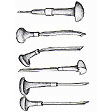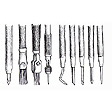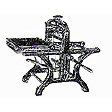
The engraver's studio
Artistic techniques







 Different types (profiles) of xylograhic burins |
We understand by engraving the result of the work carried out upon a wooden or metal surface, called plate, by means of sharp or pointed instruments, or acids that attack the metallic surface. The result is the print, a support generally made of paper to which the image has been transferred by means of the ink, when the sheet is brought into contact with the inked engraved plate and presure is exerted with a rolling or a vertical press. By extension, the print made in this way is also called engraving, so that the process is confused with the result. There are different techniques for working metal plates: etching, aquatint, burin engraving, drypoint and lithography. a) Etching is the engraving procedure in which the iconographic theme is drawn with a metallic point on a metallic plate covered by a thin layer of protective varnish. By drawing on, the protective varnish is removed. When the plate is placed in an acid bath, or aqua fortis (nitric acide), the corrosion of the metal occurs in the areas previously drawn, that is, in which the protective varnish has been removed. b) Aquatint is an engraving procedure that consists in pouring a uniform layer of resin onto the plate. Then the plate is heated for the resin to melt and adhere. Subsequently, it is introduced into acid, which penetrates into the parts where the surface is not protected by the resin. Aquatint is almost always associated with etching. On the same plate, both techniques complement each other: the drawing is defined by the etching procedure, and the aquatint is used to fill the surfaces and achieve the contrasts of light and shades. c) Burin engraving is the procedure of engraving on a highly polished metal plate, making very deep incisions using a tool called burin, which removes filings from the plate itself. The resulting grooves are filled with ink, which will pass onto the paper when the two surfaces come into contact. d) Drypoint is, like burin, a direct engraving technique. It involves drawing directly on the metal plate with a steel needle or dry point. The tip of the dry point is finer than that of the burin and edgeless, so that it scratches the metal producing grooves that can be deep but not very wide. The raised metal remains on the sides of the incisions, forming the so-called burrs or barbs. When inking the plate, these burrs retain more ink and their result on the print is an apparently wider and blurred line on the sides, which gives the print the delicate and velvety appearance that characterizes it. The burrs wear away quickly in the successive impressions, and with their erosion the characteristic effect of the technique is lost. Therefore, drypoint does not support many print runs. e) Litography is a different and more evolved technique in relation to debossed engraving. It involves drawing with a grease pencil, or lithographic pencil, on a calcareous stone called lithographic stone. To fix this drawing and ensure that the grease will not pass to the areas without it, the entire stone is covered with a light film of acidic gum arabic. The stone is then moistened with water. The zones without drawings absorb the water, and those with them, and threfore covered with the greasy component, reject it. Next, a roller impregnated with greasy ink is passed over the stone. Again, the ink is deposited only on the drawn areas, since the humidity of the part without drawing repels the ink. Finally, the engraving is stamped with the help of the lithographic press, which transfers the ink that is deposited in the drawn part of the stone to the paper. Basic engraving vocabularyBurin: Steel prismatic-section bevel-shaped tool of a prsmatic section, whose vertex is used to engrave the metal. It is mounted on a wooden handle shaped like a mushroom. Plate: Sheet of wood or metal (cupper, etc.) prepared to be stamped. Drypoint: Steel needle of circular cross-section, with and edgeless tip, which is finer than that of the burin. Barbs: Grooves raised in the scratch edges on the plates engraved with a drypoint. Roll-over press: Press to stamp chalcographic engravings that is formed by two lateral supports on which two solid cylinders rest. The pressure exerted by the two cylinders causes the ink from the plate to pass onto the paper. Vertical press: Machine designed to produce a vertical pressure that brings two surfaces into contact. The upper plate descends, pulled by a lever, upon the lower plate or platen, which remains fixed. Acidulation: Preparation with acids to which the drawn lithographic stones are subjected. Its purpose is to clean the stone of greasy particles so that the water might soak the entire undrawn surface and make the pencil and ink insoluble in water. Lithographic stone: Limestone with carbon dioxide. To draw on them, it is necessary to polish them beforehand. The most suitable ones are those taken from the quarries of Solenhofen (Munich). Lithographic pencil: A greasy pencil composed of a mixture of carbon black, wax, soap and tallow, which is used to draw on lithographic stone. See alsoBibliographyMaltese, C. (Coord.). Las Técnicas Artísticas. Madrid, 1981. Bonet Correa, A. (Coord.) Historia de las Artes Aplicadas e Industriales en España. Madrid, 1982. Gallego, A. Historia del Grabado en España. Madrid, 1979. Marisa Cancela |
|
 Points for dry engraving or etching |
||
 Printing press |
||
 |
InfoGoya 96 is an initiative of the University of Zaragoza, sponsored by the Institution Fernando el Católico of the Deputation of Zaragoza on an Apple Internet Server donated by Apple Computer. |    |